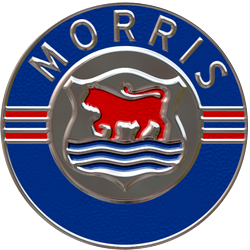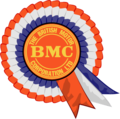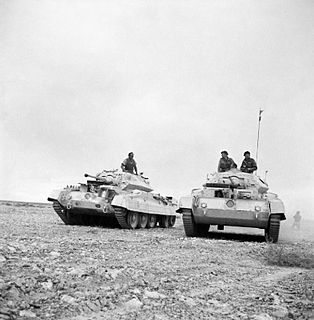
Morris Motors Limited was a British privately owned motor vehicle manufacturing company formed in 1919 to take over the assets of William Morris's WRM Motors Limited and continue production of the same vehicles. By 1926 its production represented 42 per cent of British car manufacture—a remarkable expansion rate attributed to William Morris's practice of buying in major as well as minor components and assembling them in his own factory. Self-financing through his enormous profits Morris did borrow some money from the public in 1926 and later shared some of Morris Motors' ownership with the public in 1936 when the new capital was used by Morris Motors to buy many of his other privately held businesses.

The British Motor Corporation Limited (BMC) was a UK-based vehicle manufacturer, formed in early 1952 to give effect to an agreed merger of the Morris and Austin businesses.

British Leyland was an automotive engineering and manufacturing conglomerate formed in the United Kingdom in 1968 as British Leyland Motor Corporation Ltd (BLMC), following the merger of Leyland Motors and British Motor Holdings. It was partly nationalised in 1975, when the UK government created a holding company called British Leyland, later renamed BL in 1978. It incorporated much of the British-owned motor vehicle industry, which in 1968 had a 40 percent share of the UK car market, with its history going back to 1895.
Leonard Percy Lord, 1st Baron Lambury KBE was a captain of the British motor industry.

William Richard Morris, 1st Viscount Nuffield, was an English motor manufacturer and philanthropist. He was the founder of Morris Motors Limited and is remembered as the founder of the Nuffield Foundation, the Nuffield Trust and Nuffield College, Oxford, as well as being involved in his role as President of BUPA in creating what is now Nuffield Health. He took his title from the village of Nuffield in Oxfordshire, where he lived.

Riley was a British motorcar and bicycle manufacturer from 1890. Riley became part of the Nuffield Organization in 1938 and was merged into the British Leyland Motor Corporation in 1968. In July 1969 British Leyland announced the immediate end of Riley production, although 1969 was a difficult year for the UK auto industry and many cars from Riley's inventory may have been first registered in 1970.
Armstrong Siddeley was a British engineering group that operated during the first half of the 20th century. It was formed in 1919 and is best known for the production of luxury vehicles and aircraft engines.

Nuffield Organization was the unincorporated umbrella-name or promotional name used for the charitable and commercial interests of owner and donor, William Morris, 1st Viscount Nuffield. The name was assumed following Nuffield's gift made to form his Nuffield Foundation in 1943, it linked his business interests to his existing very generous philanthropy. The same enterprises had previously been referred to as the Morris Organizations and at first described itself as The Nuffield Organization, A Cornerstone of Britain's Industrial Structure.

Wolseley Motors Limited was a British motor vehicle manufacturer founded in early 1901 by the Vickers armaments combine in conjunction with Herbert Austin. It initially made a full range, topped by large luxury cars, and dominated the market in the Edwardian era. The Vickers brothers died and, without their guidance, Wolseley expanded rapidly after the war, manufacturing 12,000 cars in 1921, and remained the biggest motor manufacturer in Britain.

Morris Oxford is a series of motor car models produced by Morris of the United Kingdom, from the 1913 bullnose Oxford to the Farina Oxfords V and VI.

E G Wrigley & Co Limited was a British tool maker, car component, and mechanical parts manufacturer, located at Foundry Lane, Soho, Birmingham active from 1897 to 1923.

Léon Bollée Automobiles was a French company founded by Léon Bollée in Le Mans to build a first vehicle called "Voiturette".
Morris Cowley was a name given to various cars produced by Morris from 1915 to 1958.

White and Poppe Limited owned a Coventry proprietary engine building and gearbox manufacturing business established in 1899. Many early motor vehicle manufacturers making only a small number of vehicles bought in their major components and White and Poppe soon had a large customer base and by 1914 a staff of around 350 people. By then the number of these customers, once as high as 15 or more, had fallen away though not the production volume leaving Dennis Brothers, always an important customer, taking much of their output.
British Motor Corporation (Australia) was a motor manufacturing company formed in Australia in 1954 by the merger of the Austin Motor Company (Australia) and Nuffield (Australia) Pty Ltd. This followed the merger in 1952 of the Austin Motor Company and the Nuffield Group in the United Kingdom to form the British Motor Corporation. Following further corporate changes in the UK in the late 1960s, BMC Australia was absorbed into the newly established British Leyland Motor Corporation of Australia, the name of which became Leyland Motor Corporation of Australia in 1972, and then JRA Limited in March 1983.

Nuffield Mechanizations and Aero Limited, also known as Mechanizations and Aero Ltd and Nuffield Mechanizations Ltd was Lord Nuffield's personal enterprise developing improved methods for mechanisation and mobility of the British Army and the ground section of the Royal Air Force.

Frank George Woollard, was a British mechanical engineer who worked for nearly three decades in the British motor industry in various roles in design, production, and management. He was a pioneer in what is today called "Lean management," but whose work has been forgotten.

British shadow factories were the outcome of the Shadow Scheme, a plan devised in 1935 and developed by the British Government in the buildup to World War II to try to meet the urgent need for more aircraft using technology transfer from the motor industry to implement additional manufacturing capacity.
Arthur John McCormack, CBE, (1866–1936) was an English businessman and patent holder. He is principally associated with Vickers' Wolseley Motors Limited where he was MD from 1911 to 1923 when Wolseley was Britain's largest motor manufacturer.

The "bullnose" Morris Oxford is a series of motor car models produced by Morris of the United Kingdom, from 1913 to 1926. It was named by W R Morris after the city in which he grew up and which his cars were to industrialise.

















